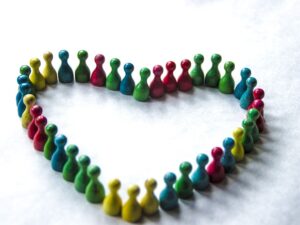DEIB or DEIBust?
By Odessa Sawyer, MSW, Program Coordinator, Center for Practical Bioethics

In 2020, the country went through a grand awareness.
Due to the pandemic, everyone’s eyes were on social media and the news. What they were witnessing were not answers about when we would go back to work and resume our normal lives but the reality that is faced by people of color, LGBTQ, indigenous peoples, people of differing abilities, women, and people of lower socioeconomic class in this country every day. Rampant police brutality, financial distress and food shortages all based on class and racial status hidden behind the veil of otherness that most people were too busy to see at a perceived distance from the problem.
A new social justice movement was born in the midst of the compounding turmoil. The pressure of the social justice movement encouraged organizations and companies to look at how their social justice stance was perceived by consumers and employees. For many of these companies the answer was to jump on the Diversity, Equity, Inclusion and Belonging (DEIB) bandwagon. New departments, trainings, coalitions and statements were created in the name of DEIB.
DEIB as New Frontier of Access?
DEIB is what many nonprofit organizations and other social services are based on, but it was revolutionary that corporations were now starting to acknowledge it. For many in the social service arena and people of a minority status it was a beacon of hope. Maybe people will be put before the dollar. Maybe we can move to a more financially equitable place and new opportunities for the voiceless can be empowered.
An upsurgence of consultants offered training and policy guidance to these corporations, with many of the consultancy owners being people of a minority status. This was a new and exciting frontier of access, power and prestige that has not been afforded to many minorities through history. An avenue to express the need for change in all aspects of our lives and address all the small cuts that have been carefully tended to in the shadows.
Or Affirmative Action Trap?
As a social worker it seemed this was a good way to go, an avenue to educate and see acceptance come to fruition. That was until DEIB was likened to affirmative action. Tossed around like a slur, a mandated role to create and fill, and used to check a box to allow for a company to behave however it sees fit. My colleagues and I in the field came to detest DEIB not for the roots from which it was started but the twisted tree that grew from the phrase. The writing was on the wall that it was not going to last or create the change that is so desperately needed. We hoped we would be incorrect in this assessment and encouraged people to use DEIB as an opening point but to continue the work deeper past the training module.
Over the last few years stories have emerged of marginalized people thrust into DEIB leadership roles. Some hopeful and joyous as they had been looking for a position in leadership. More often than not, however, was the false power that the position gave. They were picked out on the assumption that they wanted to use their lived experience to change the system. Then when they found ways to uplift needed voices, they were told the company will not operate in this manner.
The consultants that traveled the country spreading knowledge, education and hope found themselves in the same company a year later with no change or growth happening. Now five years later we are seeing in the news many companies willingly disbanding their Diversity, Equity, Inclusion and Belonging positions stating that there is no funding to continue the position. Even more alarming is the federal dismantlement of not only DEIB but the protected citizens’ laws. The ideology that people are being put into positions they are not qualified for just because they are a protected citizen is harming our society. Now companies that may have kept DEIB initiatives are being told they have to disband them or face limited funding or lawsuits. That shiny, hip new phrase is fading as well as federal protection of celebration of the contributions of people of color, women, native peoples, and people of differing abilities.
From Phrase to Movement
What about the people behind the phrase? Do they no longer matter? Are they supposed to go back to nursing the cuts from the hurtful phrases, looks and attempts to break the glass ceiling? Teaching their children, loved ones and communities how to “pass” in a world that does not honor them no matter the “ism?”
The resounding answer is no. They do not, but it is a stance we have to all take daily to ensure that the shiny phrase grows up into a movement. Just because we are no longer isolated does not mean that the voice of the dollar has changed. It is vital that we use this unbiased language to support our beliefs. There are many businesses that have not only a physical location but also a digital location so accessibility is not a barrier to supporting those voices. How we interact with our individual jobs makes DEIB become part of the culture. This call does not mean that the minority in the room has to lead the meeting, but it does mean that you ensure you save them a seat at the table, literally!
DEIB at CPB
Creating systemic change takes being intentional and having it on the forefront of everyone’s minds for every meeting. Internal efforts that the Center has to operate in a space of true diversity, equity, inclusion and belonging have taken place at several levels.
We have evaluated our employee handbook to ensure that all holidays are included to honor differences, ensure that appearance standards are not limiting, and that overall language is expressed in a way that honors the individuals that come to work with us. In hiring we make sure to use approachable, transparent language and post the job in a multitude of ways so we can meet candidates that may not be aware of the opportunities at the Center. This practice is how we are extending the table and adding chairs.
External dedication to DEIB when interacting with our partners is having every conversation come back to evaluation of who is in a position to make decisions, who is not, and having our partners have honest conversations about their culture. We have proven that when there is diversity at the table the results have no dollar limit. Having meetings with partners at locations that support local small, women, black, Hispanic or differently-abled businesses is how we put our money behind our dedication to equality.
Personal acts such as the inclusion of pronouns on email signatures, referring to your spouse as “partner,” using images in presentations that are not cis white men who are able-bodied ensure that those who are not the traditional model in will feel seen. There are bigger acts that are always welcome like donating time or money to nonprofits that you do not identify with physically or socially but you do ideologically, buying a book from an author who is not like you, and attending your local heritage celebrations. But the smaller acts consistently create long lasting change. We cannot let diversity, equity, inclusion and belonging die because if it does so the thread that makes us human dies along with it. This is bigger than a phrase: It is a movement towards harmony.


